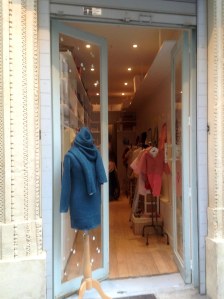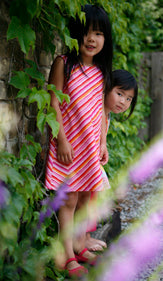As I prepare for the opening of the One of a Kind Show & Sale*, which begins next week in Toronto, I’m looking forward to seeing the work of hundreds of other craftspeople, or more broadly, makers; artists, designers, cooks, small-scale entrepreneurs. It’s energizing being in a room with so many people who have similar aspirations and challenges. Some people work alone and others have partners or staff who contribute to certain aspects. Some approach this work as art, and others as business, but even though our products and goals vary we have a lot in common.
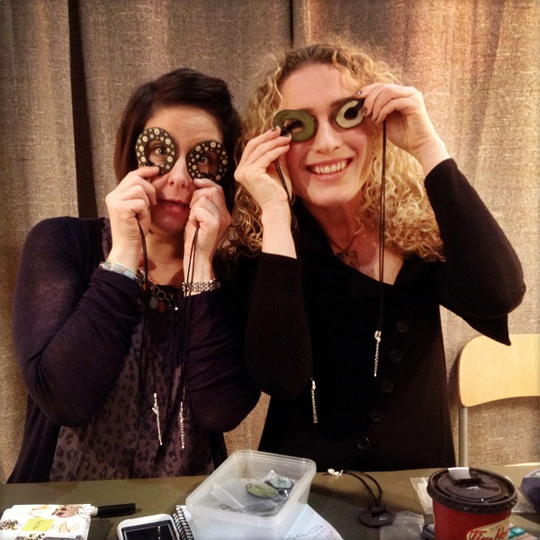
Potter Sandra Silberman (right) and jeweler Danielle O’Connor enjoying a light moment with Sandra’s porcelain necklaces at the One of a Kind Show
Many people who appreciate handmade goods wonder about the lives of the people who make them. For those wonderful people who support us and are genuinely curious about this unusual way of making a living, here are my completely subjective top ten facts about career craftspeople:
1. It’s a tough way to make a living.
Sometimes the price tags on handmade goods seem high, but when you factor in the labour and skill, and the material and overhead costs involved in producing things this way, profits tend to be slim. While we are occasionally blown away by stories of artists or designers striking it rich, the vast majority make do with incomes that are modest – and that is putting it politely. Some of us supplement our incomes through teaching, adding a wholesale element to our businesses, or doing other work part-time. Some of us draw upon an entrepreneurial passion to squeeze the maximum possible benefit from our creative efforts. Any way you approach this work, it’s a challenging ride.
2. Most of the time, we love what we do.
Most people know the joy of creating something with their own hands, or conceiving of something and then watching it come to fruition. For many of us it feels like a privilege to be able to live a creative life, and despite the challenges, we don’t take that feeling for granted. It’s a thrill to create something and then see others enjoying it.
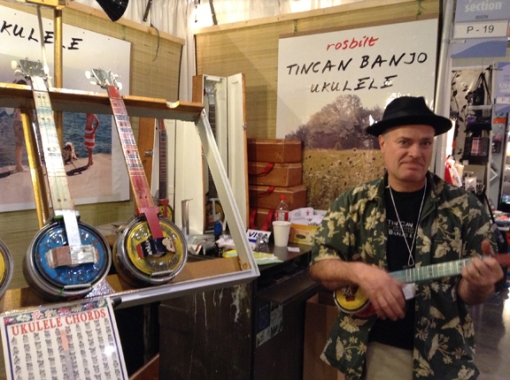
Ross Stuart makes tin can banjos and ukuleles that sound fantastic. You won’t find anything like this at the mall.
3. We have a high tolerance for risk and ambiguity.
People who prefer to walk down a clear, linear path in their lives do not often choose to be artists or craftspeople. It’s a topsy-turvy world, and you never know what will happen next. We need to be brave enough to take risks with our work and to make mistakes, and smart enough to learn from them. Last year Forbes Magazine named “a tolerance for ambiguity” as “the one key trait for successful entrepreneurs” and I think that easily applies to artists and makers as well.
4. We’re jealous of your paycheque, but not enough to quit.
Once in a while, when our customers spend large amounts of money with ease, we feel a tiny bit envious of their financial security. Ironically, some of us could not afford to buy our own products if they were made by others (a reality that we sometimes overcome by trading goods with one another). But most of us feel that the freedom to direct the course of our work lives creatively and with an entrepreneurial spirit wins out over the security of a steady paycheque.
5. We have a strong sense of community.
The camaraderie that develops at craft shows is unbeatable. For most artists and craftspeople, work is quiet, focused, and solitary or in small groups. Bring hundreds of us together, and we’re an instant community. Give us a crisis and we will work together to overcome it. I have witnessed collections taken up by strangers for fellow show exhibitors who have suffered a great personal or financial loss, people rushing to help rescue artwork from a collapsing booth, and generous sharing of tools, supplies, and labour. When the show is done, we celebrate our successes and count our losses together.
6. We’re vulnerable to theft.
As the audience for handmade goods has grown, so has the frequency of knockoffs. On sites like Etsy, for example, where many craftspeople sell their work, there have been several documented cases of goods being rampantly copied and sold as original handmade pieces. This image from the Etsy website shows twelve sellers of a virtually identical necklace, with eleven of the sellers shipping from China and all claiming that the necklace is handmade. I wonder who designed the first one. There are many cases of larger companies copying the work of small-scale artists without any acknowledgment or compensation, and it’s a tough battle to fight.
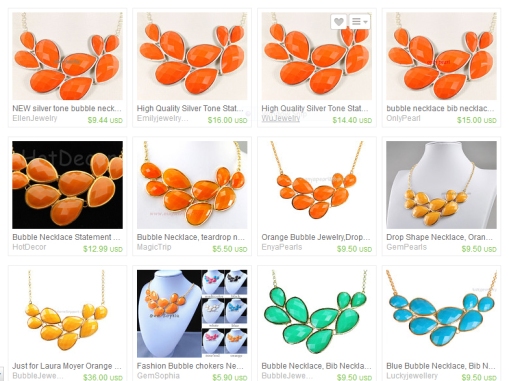
Etsy sellers who are upset with the growing number of knockoffs on the site have been creating product ‘treasuries’ like this one to illustrate their concern.
7. We’re sensitive.
If you declare to your best friend that you think our work is ugly or overpriced and we are standing right next to you, we can hear you and our feelings will be hurt. And if you try to haggle with us over price, we will be offended. Would you ask your dentist or accountant for a discount? For many of us, this is the way we earn money to support our families. And like everyone, we want our work to be valued.
8. We’re tough.
If a storm damages our display, we’ll fix it on the spot with whatever materials we can find. A challenging year for sales? We’ll design something new, or reach out to our customers in different ways. Tenacity is the norm in the world of handmade, and I’m constantly impressed by the grit and determination of my fellow makers.
9. We like media attention.
Even those of us who are shy appreciate having our work featured in the media. For a large company, being featured in a magazine’s list of “fabulous finds” is likely one of countless PR activities, but for a small-scale maker it can have tremendous impact. If you work for a media outlet that promotes products, consider promoting handmade to your audience. The spin-off benefits of promoting small can be big, benefiting both makers and consumers.
10. We appreciate our customers deeply.
Even though we chose to do this for a living, we couldn’t do it without our customers. When you support a maker by buying their work, you are helping to create the right conditions for more good work to be created. How do we show our appreciation for this support? We endeavour to make art or to design products that will give you enjoyment, value and pleasure. We listen to you and try to create pieces that you will love. And in a world where so much is cheaply manufactured and disposable, we work to create things of real quality. We appreciate you deeply for making this possible.
Sincerely,
Devorah Miller
Red Thread Design
Red Thread Design will be at the One of a Kind Show in booth R-30
*The One of a Kind Show and Sale takes place from November 28-December 8, 2013 in Toronto. More information is available on the show website
You can see Ross’s tin can instruments at http://www.thegreatmush-uke.com/ or visit him at the One of a Kind Show in booth X-24
Sandra’s beautiful “Dotti Potts” porcelain can be found at http://www.dottipotts.com/ or at the show in booth R-32
You can’t see any of Danielle O’Connor’s gorgeous jewelery in this post, but you can check it out at http://danielleoconnorjewellery.com/ or in booth T-33















